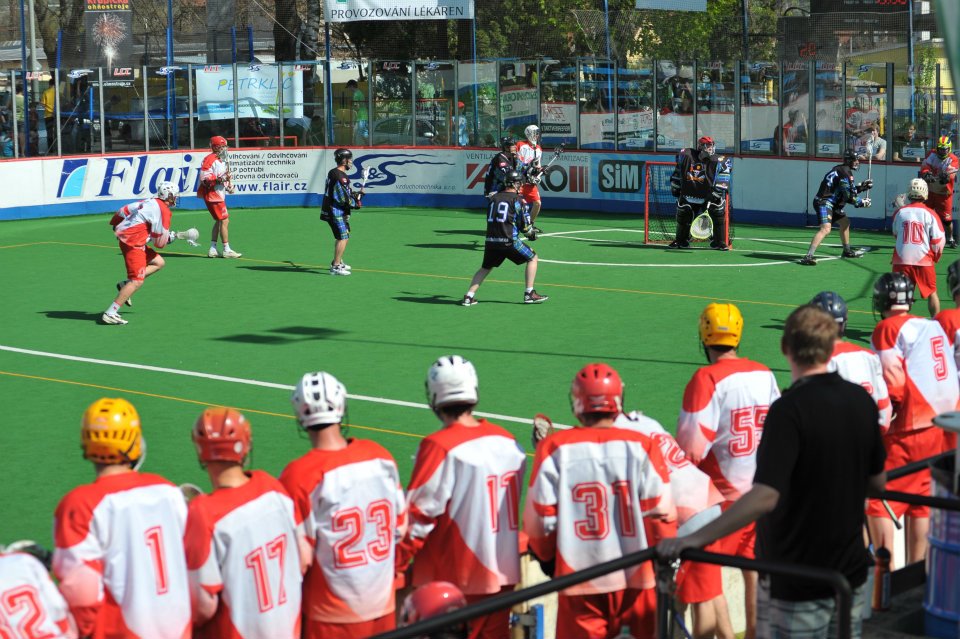Tactics Analysis:
Power Play
Power-Play/5-On-4/4-On-3/5-On-3/2-2-1 Formation/2-1-2 "Dice" Formation:
A numerical advantage on the floor as a result of a player on either team taking a penalty. A power-play is the result of 2-minute minor and/or 5-minute major penalties, taken by one team or the other. During a “5-on-4,” teams will usually set-up in a 2-2-1 formation (standard offensive positions), but a 2-1-2 ("dice") formation is also used, and sometimes a player behind the net (1-2-2). There is generally less interchange between positions during a power-play, with players instead having assigned roles in set-positions, using set-plays or Freelancing.
Note: most power-play set-plays could also be utilized as 5-on-5 set-plays
When a 4-on-3 situation arises, offensive players generally set-up in a square formation (offensive version of the "box"), occupying the two shooter and crease positions.
A 5-on-3 power-play traditionally still sets up in a "box" offensive formation (4-on-3), with the 5th player standing near centre-floor acting as a "rover" on any loose balls, or opportunities the defense may have to breakout. Double-teaming the ball after losing it ensures the deadly 4-on-3 time gets maximized.
A 5-on-4 power-play should strive to score 50%; whereas a 4-on-3 power-play is expected to score 75% of the time; both percentages can be skewed by actual power-play lengths (see coincidental penalties).
"2-2-1." Usually before any set-play or shot is initiated, a team's most skilled players will begin by first passing the ball once “around the horn,” unless trying to catch the other team off guard ("quick hitter"). Early diagonal passes should be avoided, as well as early shots with relatively little or no ball motion and/or "ball movement," which are essential in creating quality shots. When less than 10 seconds are left in a penalty, no shots should be taken until just before the penalized player returns to the play; for fear of a turnover resulting in a breakaway (unless this player is an egg & spooner or the team is down a few goals late in the game).
Aside from these general team rules, teams will either freelance or execute a set-play within each power-play possession (re-set), with the goal of getting an open shot in the prime scoring area. Freelancing doesn’t mean to stand and shoot whenever a player feels like it. Ball movement should be quick and players should still be moving, cutting when the ball is low at the crease position, dragging, and always filling. As a general rule, the opposite-side (off-ball) shooter should cut the middle every time the ball-side crease player gets the ball (with all players "filling" accordingly); the strong-side shooter should seal their check whenever the point player starts dragging towards them (both are considered automatic triggers).
Most set-plays on the power-play involve some sort of overload, via a pick or multiple picks, combined with some sort of ball/player movement; all at specific times (established during practice). Following a shot, players need to be ready to react immediately (this should always be re-enforced during practice - offensive players must also be taught how to double-team properly). Defensive coverage against reverse transition is the first responsibility, but more often than not there is an opportunity to Ride and double-team. Teams should do their best to apply pressure once general coverage has been established, in order to create a 10 second call or a turnover. If they are tired or unsuccessful, the back-up (Power Play #2) unit usually then gets the next opportunity on offense. If the 2nd unit is playing better than the 1st unit during a game, or over a stretch of games, it should be considered whether to make them “starters,” or mix up the line-up entirely (see coaching strategy).
"2-1-2." When playing the "dice" formation (2-1-2), set-plays and freelance may also be used; usually with a teams best picker/finisher in the middle. The added advantage of this formation is in causing miscommunication amongst defenders as to who is responsible to cover the middle the middle player, and in what situations (requires high lacrosse IQ on the defenders' behalf). During freelance, the middle player can pick anywhere and also try to find soft spots for quick catch and shoot scenarios; primarily staying on their proper floor side. All other players should utilize the picks being set for them (otherwise presenting a decoy), while being careful not to force passes into the middle player (60-40 passes only).
*Consider practicing powerplay vs. short-handed at 2 minute timed intervals (3 attempts max), which is the most game-specific way to practice
- Categories: Free / Playbook / Power Plays / Beginner
